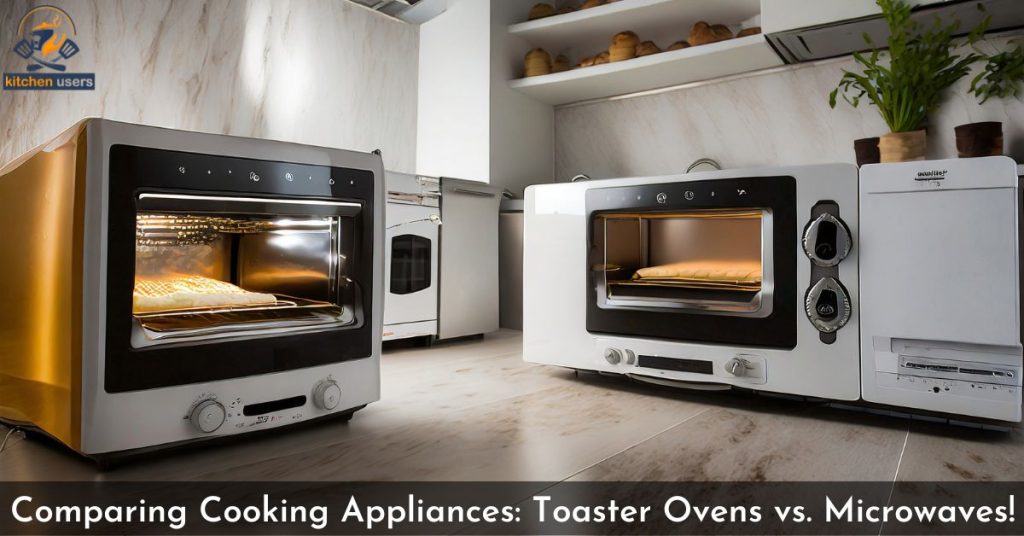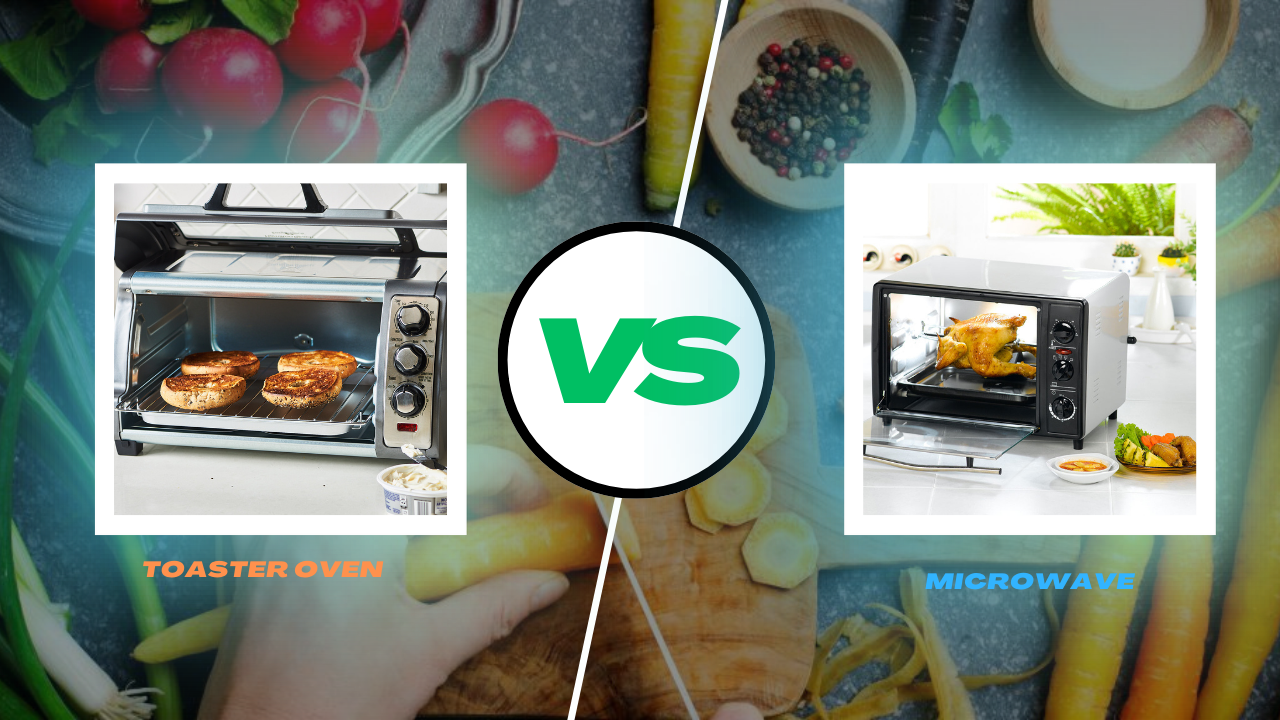Welcome once again, my dear cooking lovers! I’m Tammy E. Edison, an experienced expert in kitchen appliances. I’ve had the honor of personally seeing the culinary revolutions that microwaves and toasters have brought about. These two countertop appliances have become staples in modern kitchens. Each is offering unique advantages and appealing to different cooking styles.
But when it comes to choosing between these two appliances, the question often arises: “Toaster Ovens vs. Microwaves: which one reigns supreme?” The toaster oven, with its ability to toast, crisp, and bake, or the microwave, with its lightning-fast reheating capabilities.
Today, I’ll delve into this culinary problem from my practical experience, exploring the strengths and limitations of each appliance to determine which one deserves the title of kitchen countertop champion. So, let’s get started!
Comparing Cooking Appliances: Toaster Ovens vs. Microwaves!

Toaster ovens and microwaves have long been staples in kitchens worldwide, offering convenient and versatile ways to heat, cook, and reheat food. While both appliances serve similar purposes, they differ significantly in their cooking methods, cooking times, and suitability for various culinary tasks. Understanding these distinctions is crucial for making an informed decision when choosing between the two.
01. Toaster Ovens vs. Microwaves Cooking Process
Toaster Ovens: Toaster ovens employ convection heating, utilizing heating coils to generate infrared radiation that warms the surrounding air. This heated air then circulates within the oven, evenly cooking food from all sides. This method excels at browning and crisping food, making it ideal for toasting bread, roasting vegetables, and baking small dishes.
Microwaves: In contrast, microwaves employ microwave radiation, a form of electromagnetic energy that directly penetrates food and excites water molecules. This rapid agitation of water molecules generates heat, cooking food from the inside out. Microwaves are renowned for their quick and efficient heating, making them perfect for reheating leftovers, defrosting frozen foods, and preparing simple meals.
Winner For browning and crisping capabilities, toaster ovens reign supreme. Their convection heating method mimics conventional oven cooking, producing crispy exteriors and flavorful results. Microwaves, on the other hand, excel at rapid and uniform heating, making them ideal for quick reheating and defrosting tasks.
02. Toaster Ovens vs. Microwaves Cooking Time
Toaster Ovens: Toaster ovens typically require longer cooking times compared to microwaves due to their slower heating process. Toasting bread may take a few minutes, while roasting vegetables or baking small dishes can range from 10 to 20 minutes.
Microwaves: Microwaves, on the other hand, are known for their exceptional speed. Reheating leftovers or defrosting frozen foods often takes just a few minutes, making them a convenient choice for quick meals or snacks.
Winner When it comes to speed, microwaves take the clear victory. Their rapid heating method is unrivaled, making them ideal for situations where time is of the essence. Toaster ovens, while slower, offer more versatility in cooking techniques, allowing for browning, crisping, and roasting.
03. Toaster Ovens vs. Microwave Installation
Toaster Ovens: Toaster ovens offer straightforward installation, typically requiring only placement on a stable, heat-resistant surface and ensuring adequate clearance around the appliance for ventilation. Most toaster ovens come with plug-and-play capabilities, making them ready for immediate use.
Microwaves: Microwaves typically require more involved installation, often involving mounting on a wall or above a range. This process may involve drilling and securing the microwave to the mounting bracket, ensuring proper electrical connections, and maintaining adequate clearance for ventilation.
Winner In terms of ease of installation, toaster ovens emerge victorious. Their simple placement and plug-and-play operation make them ideal for quick and hassle-free setup. Microwaves, while still manageable for most users, require more effort due to their mounting requirements and electrical considerations.
04. Toaster Ovens vs. Microwaves Size
Toaster Ovens: Toaster ovens come in a variety of sizes to suit various kitchen spaces and cooking needs. Compact countertop models are ideal for toasting bread, reheating small portions, and occasional baking tasks. These appliances typically measure around 10-12 inches in width, 10-12 inches in depth, and 8-10 inches in height.
Larger toaster ovens, designed for more versatile cooking, can accommodate baking pans and roasting dishes. These models typically measure around 15-18 inches in width, 15-18 inches in depth, and 12-14 inches in height.
Microwaves: Similarly, microwaves offer a range of sizes to fit different kitchen configurations. Compact tabletop models are ideal for small kitchens or dorm rooms, measuring around 12-14 inches in width, 14-16 inches in depth, and 10-12 inches in height.
Larger countertop microwaves provide more cooking capacity and often come with additional features, such as convection cooking or grill capabilities. These models typically measure around 18-22 inches in width, 18-22 inches in depth, and 12-14 inches in height.
Winner In terms of size flexibility and adaptability to various kitchen spaces, microwaves hold a slight edge over toaster ovens. Their broader range of sizes, from compact tabletop models to larger countertop options, caters to a wider range of user needs and kitchen setups.
05. Toaster Ovens vs. Microwaves Costs
Toaster Ovens: Toaster ovens generally exhibit a wider range of prices compared to microwaves. Basic toaster ovens can be found for as low as $20, while more advanced models with additional features, such as convection cooking or temperature control, can range from $50 to $100.
Microwaves: Microwave prices tend to be more consistent, with basic models typically starting around $50 and mid-range models with additional features falling within the $100-150 range. High-end microwaves with advanced features, such as convection cooking or sensor cooking, can reach prices of $200 or more.
Winner For budget-conscious buyers, toaster ovens offer more affordable options, with basic models available for as low as $20. However, microwaves generally offer more consistent pricing, with most models falling within the $50-150 range. The choice ultimately depends on individual needs, preferences, and budget constraints.
06. Toaster Ovens vs. Microwaves Energy Efficiency
Toaster Ovens: Toaster ovens typically consume more energy than microwaves due to their convection heating method, which requires heating coils to generate infrared radiation and circulate heated air within the oven. Average toaster ovens use around 1,200-1,800 watts of power.
Microwaves: Microwaves, on the contrary, are renowned for their energy efficiency. Their microwave radiation directly penetrates food, generating heat from the inside out. This method requires less power, with average microwaves consuming around 700-1,300 watts.
Winner Microwaves emerge as the clear winner in terms of energy efficiency. Their lower power consumption translates to reduced energy costs and a smaller environmental footprint.
07. Toaster Ovens vs. Microwaves Ease of Use
Toaster Ovens: Toaster ovens generally offer straightforward operation, with simple controls for toasting bread, reheating food, and baking small dishes. However, more complex tasks, such as roasting vegetables or baking elaborate dishes, may require more attention and manual adjustments.
Microwaves: Microwaves are known for their user-friendly design and intuitive controls. Many models feature preset options for common tasks, such as reheating leftovers, defrosting frozen foods, and preparing popcorn. Additionally, microwave power levels are easily adjustable, allowing for precise control over cooking times and heat intensity.
Winner Microwaves reign supreme in terms of ease of use. Their simple controls, preset options, and adjustable power levels make them ideal for quick and hassle-free cooking. Toaster ovens, while generally easy to operate, may require more manual effort for complex tasks.
08. Toaster Ovens vs. Microwaves Maintenance
Toaster Ovens: Toaster ovens generally require more frequent maintenance compared to microwaves. Their heating coils and crumb tray need regular cleaning to prevent food buildup and ensure optimal performance. Additionally, the interior and exterior of the toaster oven should be wiped down regularly to maintain cleanliness.
Microwaves: Microwaves are relatively low-maintenance appliances. Their interior surfaces typically only require occasional cleaning with a damp cloth to remove food splatters. The exterior can also be wiped down with a damp cloth. However, it’s important to avoid using harsh chemicals or abrasive sponges, as these can damage the microwave’s finish.
Winner Microwaves emerge as the winner in terms of maintenance. Their smooth interior surfaces and minimal cleaning requirements make them easier to maintain compared to toaster ovens, which require more frequent cleaning of their heating coils and crumb tray.
09. Toaster Ovens vs. Microwaves Safety
Toaster Ovens: Toaster ovens are generally safe appliances. However, here is a toaster oven safety tips guide. It’s important to exercise caution when handling hot food items and to avoid placing flammable materials near the toaster oven during operation. Additionally, unplug the toaster oven when not in use and allow it to cool completely before cleaning.
Microwaves: Microwaves are also considered safe appliances when used correctly. It’s important to follow the manufacturer’s instructions and avoid using metal containers or utensils inside the microwave. Additionally, avoid overfilling the microwave, as this can lead to spillage and potential hazards.
Winner Both toaster ovens and microwaves can be considered safe appliances when used properly
10. Toaster Ovens vs. Microwaves Limitations
The Toaster ovens and microwaves, despite their versatility, have their own set of limitations that should be considered when making a choice.
Toaster Ovens Limitations:
- Longer cooking times: Toaster ovens generally require longer cooking times compared to microwaves due to their slower heating method. This can be inconvenient for tasks that require quick reheating or defrosting.
- Uneven cooking: While toaster ovens can achieve browning and crisping, they may not always provide even cooking throughout the food. This can be an issue for larger or thicker dishes.
- Limited cooking options: Toaster ovens are primarily suited for toasting bread, reheating leftovers, and baking small dishes. They may not be ideal for preparing more elaborate meals or cooking large quantities of food.
Microwaves Limitations:
- Limited browning and crisping: Microwaves are not known for their ability to brown or crisp food due to their heating method. This can result in food that is soft and lacking texture.
- Potential for uneven heating: Microwaves can sometimes cause uneven heating, with certain areas of the food becoming overheated while others remain cold. This can be addressed by rotating or rearranging the food during cooking.
- Not suitable for all foods: Microwaves are not ideal for cooking all types of food, particularly those with high moisture content or delicate textures.
11. Toaster Ovens vs. Microwaves: Which is Better for you?
Toaster ovens and microwaves are both versatile kitchen appliances that offer convenient ways to heat, cook, and reheat food. However, they differ significantly in their cooking methods, cooking times, and suitability for various culinary tasks.
Toaster Ovens Ideal for:
- Browning and crisping food
- Toasting bread
- Reheating leftovers
- Baking small dishes
- Roasting vegetables
Microwaves Ideal for:
- Quick reheating of leftovers
- Defrosting frozen foods
- Preparing simple meals
- Cooking liquids
- Heating beverages
In summary, toaster ovens are a good choice for those who want to brown and crisp food, while microwaves are a good choice for those who want to reheat food quickly and easily.
My Opinion ----------------------- If you prioritize browning and crisping capabilities, a toaster oven is the better choice. It's ideal for tasks like toasting bread, roasting vegetables, and baking small dishes. However, if you prioritize quick reheating and defrosting, a microwave is the clear winner. It's also easier to use and operate, making it a convenient choice for everyday cooking tasks. Ultimately, I believe that both toaster ovens and microwaves have their place in the kitchen. Having both appliances provides you with the flexibility to handle a wider range of cooking tasks.
Toaster oven vs. Microwave for cooking specific types of food

Toaster ovens and microwaves each have their strengths and weaknesses when it comes to cooking specific types of food. Here’s a table of which appliance is better for different types of food:
| Food Type | Recommended Appliance | Reason |
|---|---|---|
| Toast | Toaster oven | Superior browning and crisping for toast |
| Breadcrumbs | Toaster oven | Dries out bread to the perfect consistency for breadcrumbs |
| Reheating | Microwave | Fastest and most efficient way to reheat leftovers |
| Defrosting | Microwave | Quickest and most even way to defrost frozen foods |
| Cooking vegetables | Toaster oven | Roasts vegetables to a tender and flavorful finish |
| Baking small dishes | Toaster oven | Versatile for baking small cakes, muffins, and casseroles |
| Heating liquids | Microwave | Fastest and most efficient way to heat liquids |
| Browning meats | Toaster oven | Sears and browns meats for a flavorful finish |
| Cooking grains | Microwave | Cooks grains like rice and quinoa quickly and evenly |
| Making popcorn | Microwave | Quickest and most convenient way to make popcorn |
| Cooking large quantities | Microwave | Better suited for cooking larger quantities of food due to larger capacity |
Toaster oven vs microwave for overall cooking performance
Both toaster ovens and microwaves are versatile kitchen appliances that offer unique advantages for different cooking tasks. Toaster ovens excellent at toasting bread, reheating leftovers, and baking small items like cookies or muffins. They can also be used to roast vegetables or cook small pizzas. Microwaves, on the other hand, are known for their speed and convenience when it comes to reheating food or defrosting frozen items. They are also well-suited for cooking liquids, such as soups and sauces.
When it comes to overall cooking performance, the choice between a toaster oven and a microwave depends on your individual needs and preferences. If you frequently toast bread or reheat leftovers, a toaster oven may be a better choice. If you need a quick and easy way to heat up food or defrost frozen items, a microwave is a better option. Ultimately, the best appliance for you is the one that best meets your cooking needs.
Tips for Buying and Using
To ensure you get the most out of your toaster oven and microwave, here are some helpful tips for selecting the right appliance for your needs and using it safely and effectively.
Toaster Ovens Buying Tips:
- Consider your needs and preferences: Determine what you primarily use a toaster oven for, whether it’s toasting bread, reheating leftovers, or baking small dishes. Choose a model that suits your specific needs.
- Size matters: Select a toaster oven size that fits your kitchen counter and your cooking needs. Smaller models are ideal for basic tasks, while larger ones accommodate more elaborate dishes.
- Power and features: Choose a toaster oven with a power rating that matches your cooking needs. Consider additional features like convection cooking, temperature control, or preset options.
- Safety features: Ensure the toaster oven has safety features like an automatic shut-off, cool-touch exterior, and a non-slip base.
Toaster Ovens Using Tips:
- Preheat the toaster oven: Preheat the toaster oven for optimal browning and crisping. Follow the manufacturer’s instructions for preheating times.
- Use appropriate cookware: Use oven-safe cookware that fits the toaster oven. Avoid overcrowding the oven to ensure even cooking.
- Rotate food items: For larger or thicker dishes, rotate the food items halfway through cooking to ensure even browning and heating.
- Monitor cooking carefully: Keep an eye on food items while cooking to prevent overcooking or burning.
- Clean regularly: Clean the toaster oven regularly to remove food crumbs and maintain its performance.
Tips for Buying Microwaves:
- Countertop or over-the-range: Decide whether you want a countertop microwave or an over-the-range model. Countertop models offer flexibility, while over-the-range models save counter space.
- Size and capacity: Choose a microwave size that fits your kitchen counter and your cooking needs. Larger models accommodate larger dishes and quantities of food.
- Power and features: Select a microwave with a power rating that suits your cooking needs. Consider additional features like sensor cooking, convection cooking, or grill capabilities.
- Ease of use: Ensure the microwave has intuitive controls and easy-to-read settings for simple operation.
Tips for Using Microwaves:
- Use microwave-safe containers: Always use microwave-safe containers that are compatible with the power level you’re using.
- Cover food: Cover food items with a microwave-safe lid or plastic wrap to prevent splatters and retain moisture.
- Position food evenly: Arrange food items evenly on the microwave turntable to ensure even heating.
- Check for doneness: Check food for doneness halfway through cooking and adjust the cooking time if necessary.
- Clean regularly: Wipe down the microwave interior and exterior regularly to maintain cleanliness and prevent odors.
can toaster ovens cause cancer?
No, there is no scientific evidence to suggest that toaster ovens can cause cancer. Toaster ovens emit electromagnetic fields (EMFs), but the levels of EMFs are very low and far below the levels that have been linked to cancer in studies.
Some people have concerns about the chemicals that may be used in toaster ovens, such as nonstick coatings and plastics. However, there is no evidence that these chemicals leach into food at levels that would be harmful.
If you are concerned about the safety of your toaster oven, you can choose one that is made with stainless steel or other non-toxic materials. You can also avoid using nonstick coatings and plastics on your food whenever possible.
Overall, there is no need to worry about toaster ovens causing cancer. They are safe to use as long as they are properly maintain and use according to the manufacturer’s instructions.
Conclusion
Dear kitchen lovers, I hope this exploration of toaster ovens vs microwaves has provided you with valuable insights into the strengths and limitations of each appliance.
As a kitchen specialist, I believe that both toaster ovens and microwaves deserve a place in our kitchens. They complement each other beautifully, offering a range of culinary possibilities that enhance our cooking experiences.
So, welcome both of these countertop champions and let them work together to transform your kitchen into a masterpiece of flavors and feelings. Whether you’re toasting bread to golden perfection, reheating leftovers with lightning speed, or whipping up a batch of muffins, these appliances will be your faithful companions.
Please feel free to share your own microwave and toaster oven stories in the comments section below. Remember to share this article with your other kitchen lover friends. Happy cooking!

Tammy E. Edison is a distinguished specialist in the world of kitchen appliances, and she is proud to be a part of the dynamic team at kitchenusers.com. With a background in engineering and a passion for culinary innovation, Tammy E. Edison has established herself as a go-to expert for all things related to kitchen appliances technology.


